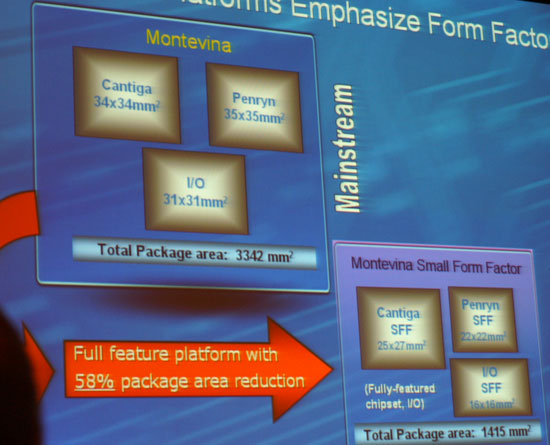Apple's MacBook Air: Uncovering Intel's Custom CPU for Apple
by Anand Lal Shimpi on January 15, 2008 12:00 AM EST- Posted in
- Mac
Intel’s SFF Merom: Just for Apple
During Jobs’ keynote, Apple mentioned that the Core 2 Duo in the MacBook Air was 60% smaller than standard Core 2 Duo processors. A quick look at Intel’s mobile Core 2 Duo datasheets reveals that indeed both the micro-FCPGA and micro-FCBGA packaged Meroms measure 35mm x 35mm. Is it possible that Intel designed a completely new package just for Apple?

It turns out that the answer is a surprising: sort-of. At last year’s Fall IDF Intel talked about Montevina, the successor to Santa Rosa due out in the second half of 2008. Montevina would combine a new chipset (Cantiga) with mobile Penryn. In addition to Montevina Intel will also release Montevina SFF, a smaller package version of the platform that reduces overall chip footprint by around 60%.

Pay attention to the size of the CPU, it drops from 35mm x 35mm down to 22mm x 22mm - Penryn SFF is around 40% of the size of regular mobile Penryn, which happens to be the same size as Merom.
It looks like Intel created Merom SFF specifically for the MacBook Air, a product that wasn’t in Intel’s lineup or roadmap but one that Apple needed. Remember that the first chip that will look like this wasn’t scheduled to be out for another six months with Montevina SFF.
It’s not clear whether Intel will make this custom Merom available to other OEMs (we’d suspect they would if there was enough demand), but it’s a tremendous feat on Apple’s part. This isn’t the first time Intel has put together a one-off chip for Apple; if you’ll remember, the CPU in the Apple TV was a special Dothan that wasn’t a part of Intel’s standard lineup.
We’ll have a look at the MacBook Air as soon as they start shipping, if you’re ordering one now we’d recommend taking the SSD option if you can afford it. At $999 it’s pricey, but it should help keep heat down in the chassis and performance should be better than the pitiful 1.8” HDD in the system, which we suspect will end up being its weak point.
We also can’t help but think that a Penryn based MacBook Air would be far more desirable thanks to lower thermal output of Intel’s 45nm chips. If you are fine waiting, a MacBook Air in the second half of 2008 will give you slightly better performance, better battery life and should keep your lap a lot cooler.










54 Comments
View All Comments
Zoomer - Tuesday, January 15, 2008 - link
Wireless is completely useless when sshing to another system remotely, in even moderate traffic settings.Draft-n approaching 100 Mbps ethernet? Dream on; it'll be great if it gets even half that.
JarredWalton - Tuesday, January 15, 2008 - link
The best I've seen in my laptop testing is around 7.5MBps of real throughput. That works out to 60Mbps - so better than 802.11g theoretical maximum, but still about 2/3 the speed of 100Mbit Ethernet. (Note also that many 802.11n chips seem to get more like 4-5MBps average rates, in ideal circumstances.) Now, go use any decent laptop these days and you get Gigabit, with speeds of around 40MBps easily achievable (the bottleneck generally being the hard drive(s) involved in transfers).yyrkoon - Wednesday, January 16, 2008 - link
7.5MB/s really is not that terrible compared to fast ethernet. Fast ethernet typically only gets 6-9MB/s from windows to windows transfers(standard file sharing), and I've personally seen 10MB/s with Linux -> Windows with Samba, and 11.4MB/s with Linux -> Windows iSCSI.GbE on the other hand really does not get much more than 30MB/s sustained for long periods of time. It has nothing really to do so much with the HDDs speeds as the disk block size vs TCP/IP packet sizes, and conversion. This of course would be on the garden variety home user type hardware, and laptop hardware should not be any better, or probably even as good. The new Windows Vista + TCP/IP stack etc, is purportedly supposed to fix this issue, but I guess we'll have to wait and see, because from what I understand it is still a work in progress.
Still, your point is made; GbE > 802.11n concerning transfers, although, if you didn't need security, firewire networking would do pretty well . . .
Anyhow for a Portable PC, I think I would rather have a modded Asus Eee, with a 80GB HDD in it. Something for mobile media files, and to have something on hand to upload RAW images to from my DSLR. Then again, I am not much for mobile system, except for what they can help me with while I am away from my desktop.
However, If I were working in the wireless internet business, etc, and needed to have a PC on a rooftop with me while aligning an antenna or something, then the Mac Air would probably be the last laptop on the planet I'd need/want.
Blauhung - Tuesday, January 15, 2008 - link
It probably has intel's draft N wireless on board which is faster then what most people have for ethernet.